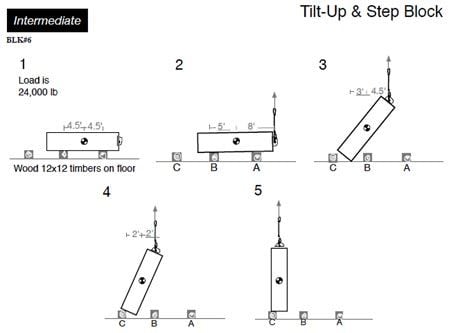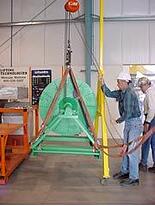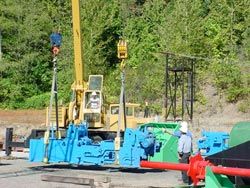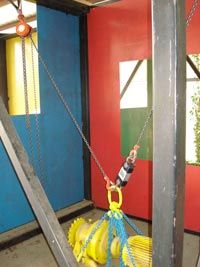In ASME B30.26-2010 Rigging Hardware volume, we recently added LID’s (load indicating devices) as the new Chapter 6. These are detachable weighing devices; generally known as dynamometers, crane scales or shackles with load-indicating pins.
The LID chapter includes 10 sections addressing: Scope, Types and Materials, Design Factor, Rated Load, Proof Test, Identification, Effects of Environment, Training, Calibration/Inspection/Repair and Removal, and Operating Practices. The new volume, ASME B30.26 can be purchased at the ITI Bookstore.
We use dynamometers for a host of reasons but four applications can be especially helpful to the rigger and crane operator.
1) During a chain hoist load drifting activity, the tension read-out can help prevent equipment overload, since the horizontal distance, the horizontal angle and the elevation are constantly changing. The rigger calculates for the worst-case drifting position, but uses the LID to ensure that he and the crew stay within the parameters intended.
2) With remote read-out to a handheld device an LID is very useful in a load up-righting event. Using an overhead crane, rigger’s often have to stand a load up, from a laydown position. By using a dynamometer from the crane hook, the actual tension will generally reduce as the rigger hoists and trolleys, to accommodate the load tilt-up. By observing the tension as it reduces, his crew can align a “step-block” in a timely manner. A “step-block” or large wooden timber is used to create a new tipping axis. This helps prevent load “flopping” when the center-of-gravity passes the tilt-up corner.

 3) A third valuable place to use an LID is during disassembly or demolition work. If a rigging crew knows a motor and gear box on a bolted and grouted base, weigh 4,500 lbs. then the LID can be placed between the crane hook and the load rigging to help prevent overload to the equipment. Sometimes the alignment rods or cement grout underneath the load’s base are not sufficiently separated from the base. In effect the base is still secured to the building’s floor. The LID (dynamometer) will provide live “tension” readout to the rigging crew. If the value in tension exceeds the known weight, the crew will need to find ways to separate the base from its mounting location (jack hammer, concrete saw, cutting torch, hydraulic spreader jack, etc.). The photo at the right shows an LID between the hoist hook and the rigging.
3) A third valuable place to use an LID is during disassembly or demolition work. If a rigging crew knows a motor and gear box on a bolted and grouted base, weigh 4,500 lbs. then the LID can be placed between the crane hook and the load rigging to help prevent overload to the equipment. Sometimes the alignment rods or cement grout underneath the load’s base are not sufficiently separated from the base. In effect the base is still secured to the building’s floor. The LID (dynamometer) will provide live “tension” readout to the rigging crew. If the value in tension exceeds the known weight, the crew will need to find ways to separate the base from its mounting location (jack hammer, concrete saw, cutting torch, hydraulic spreader jack, etc.). The photo at the right shows an LID between the hoist hook and the rigging.
 4) A crane-hook suspended dynamometer can be a helpful tool for training crane operators to be “smooth”. With the “peak-hold” function activated on the dynamometer, an operator can be signaled to lift a load, move it horizontally and lower it to a pre-approved landing point. It is not unusual for the “dynamic” weight to momentarily peak to a value of 10-50% above the known suspended weight. The peak-hold function maintains the highest captured reading on the dynamometer since it was last cleared. If the operator swings (boom crane) or travels (bridge crane) and stops abruptly, the dynamometer can register a very high peak value. It helps the trainer, demonstrate to the operator the need to manage the crane speed, acceleration and deceleration in a sensible manner. (All of this type of dynamic handling needs to be well within the crane and rigging’s capacity, generally less than 25% of the allowable rating in its configuration.) In the photo at left, dynamometers are being used for 2-crane lift training.
4) A crane-hook suspended dynamometer can be a helpful tool for training crane operators to be “smooth”. With the “peak-hold” function activated on the dynamometer, an operator can be signaled to lift a load, move it horizontally and lower it to a pre-approved landing point. It is not unusual for the “dynamic” weight to momentarily peak to a value of 10-50% above the known suspended weight. The peak-hold function maintains the highest captured reading on the dynamometer since it was last cleared. If the operator swings (boom crane) or travels (bridge crane) and stops abruptly, the dynamometer can register a very high peak value. It helps the trainer, demonstrate to the operator the need to manage the crane speed, acceleration and deceleration in a sensible manner. (All of this type of dynamic handling needs to be well within the crane and rigging’s capacity, generally less than 25% of the allowable rating in its configuration.) In the photo at left, dynamometers are being used for 2-crane lift training.
I truly hope you can see how we can benefit by using tools like LID’s to help us maintain a level of accuracy and enhance our knowledge base and experience level.
Happy trails to my crane and rigging friends,
Mike Parnell
ITI – Field Services




COMMENTS